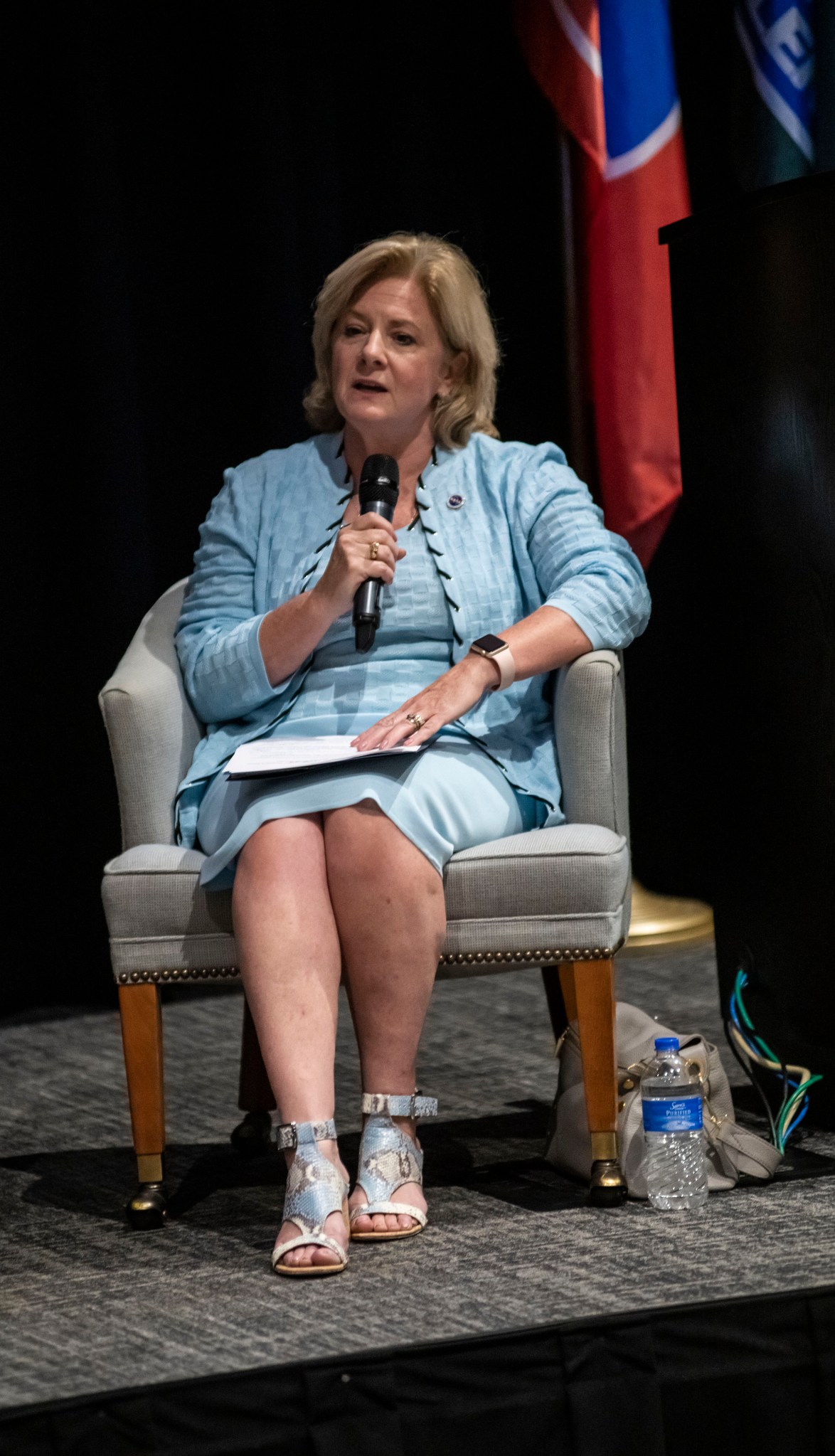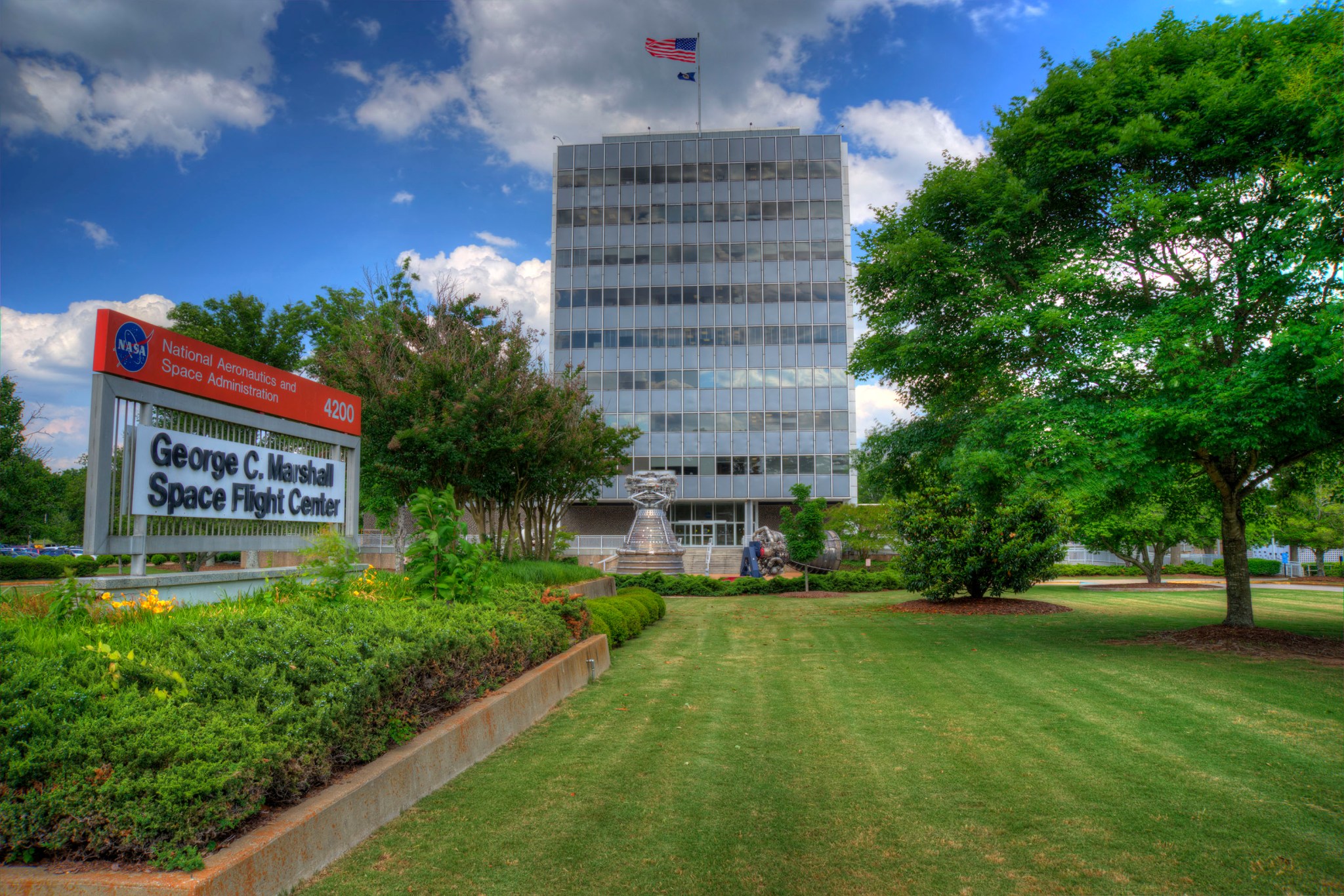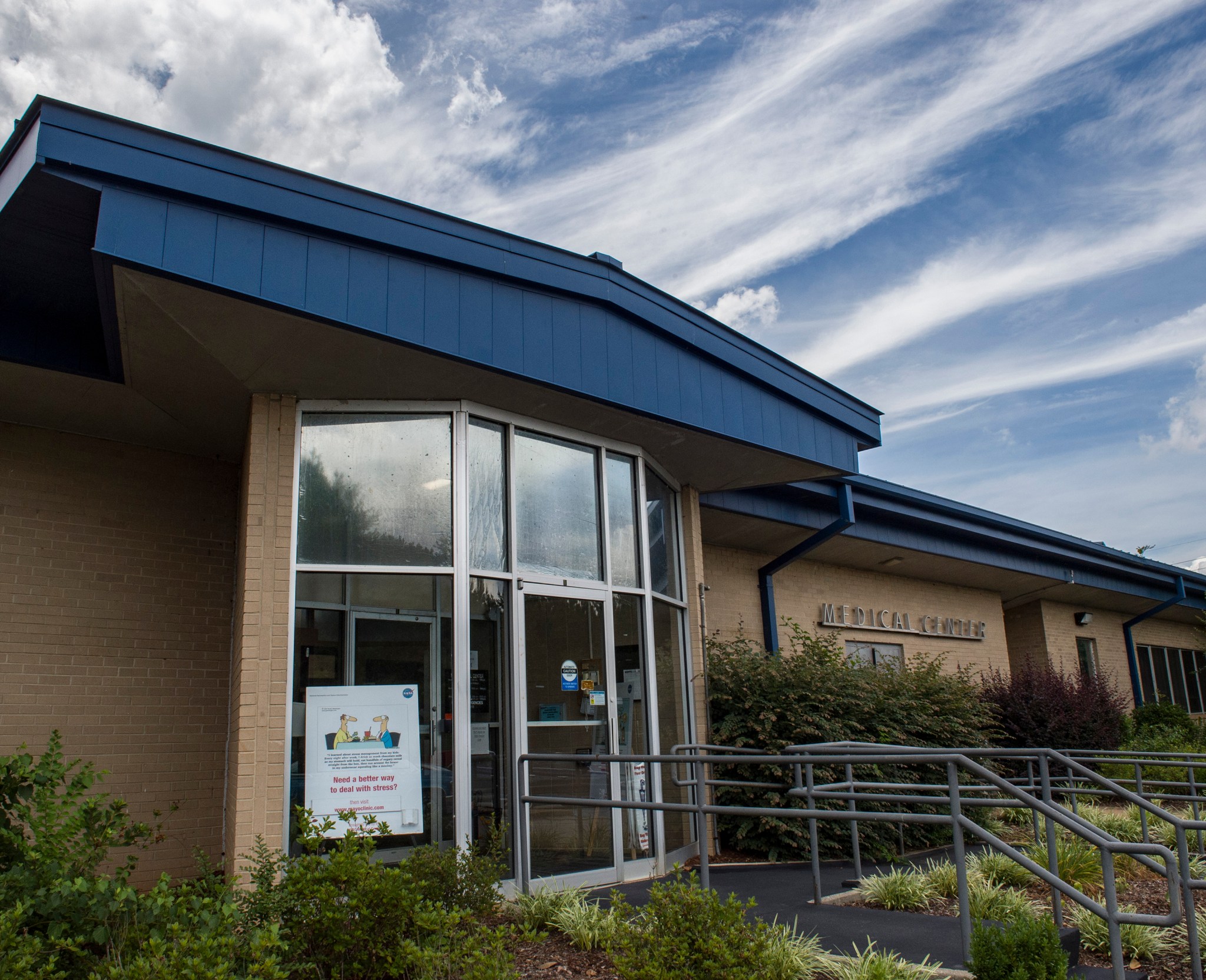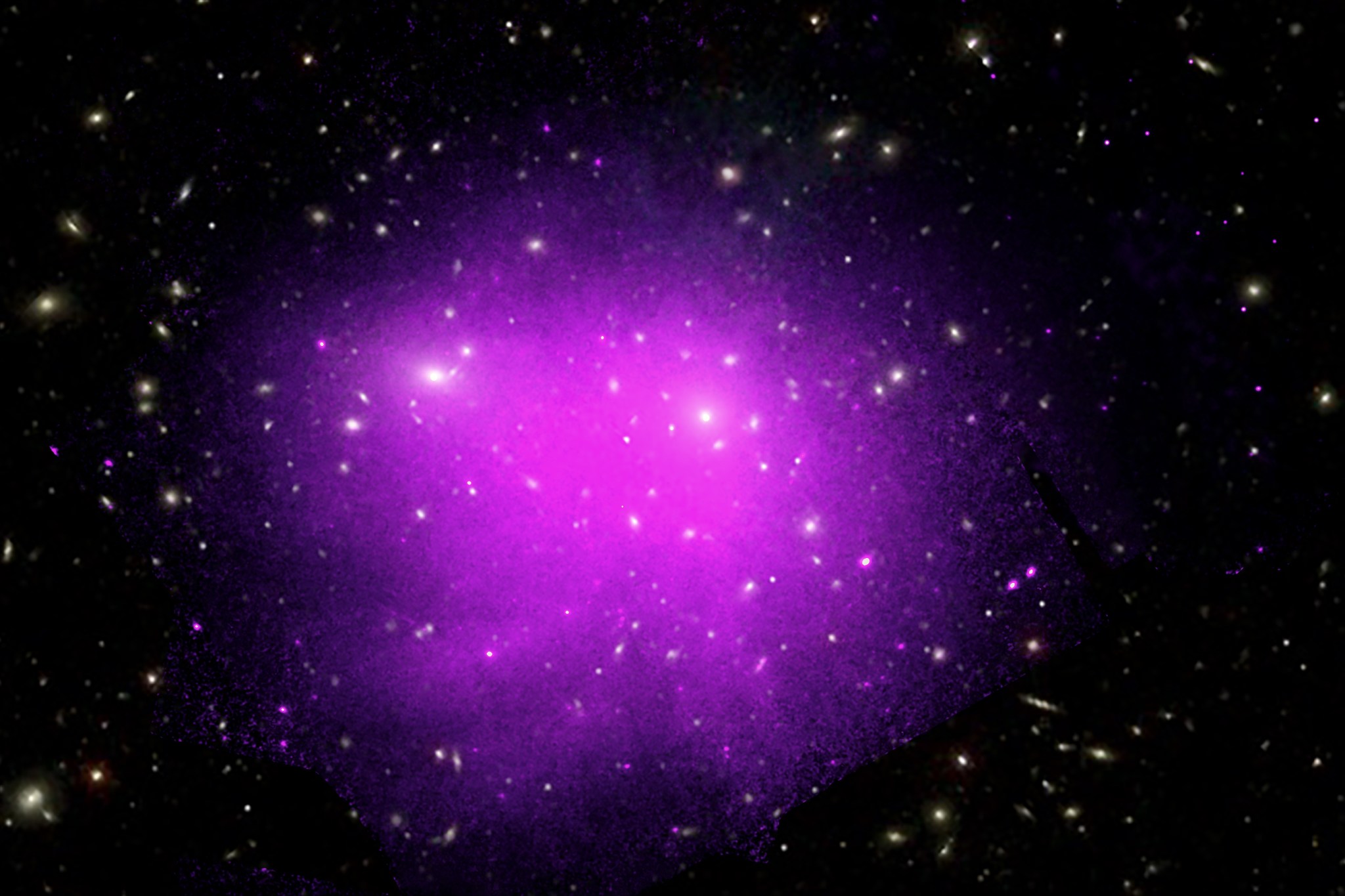In This Week’s Star
- Past, Present Marshall Directors Discuss Center’s Role in Future of Space Exploration
- NASA Associate Administrator Jurczyk, Deputy Associate Administrator Saunders Meet with Marshall Team
- Marshall Leaders: Employee Survey Vital to Success — and Data Proves It
- Volunteers Needed for World Record Rocket Launch Attempt
- Marshall’s David Burns Shares His Experiences Reactivating the SR-71 Blackbird
- Marshall Medical Center to Offer New Options to Civil Servants, Contractors
- Marshall Team, Local Partners Host ‘Take Our Children to Work Day’
- NASA Technology Missions Launch on SpaceX Falcon Heavy
- Does the Gas in Galaxy Clusters Flow Like Honey?
- I Am Building SLS: Debra King
- This Week in NASA History: Marshall Captive-Fires F-1 Engine on a First Run – June 29, 1967
Past, Present Marshall Directors Discuss Center’s Role in Future of Space Exploration
By Daniel Boyette
William Lucas envisioned great things for NASA’s Marshall Space Flight Center following the first Moon landing in 1969.
Lucas, who was one of Marshall’s original employees in 1960 and the center’s director from 1974-86, had looked decades into the future and pictured Marshall as continuing to be the agency’s premier propulsion center, while expanding its involvement in science payloads. Such contributions would, he felt, help lead to the establishment of a Moon habitat and a crew landing on Mars.
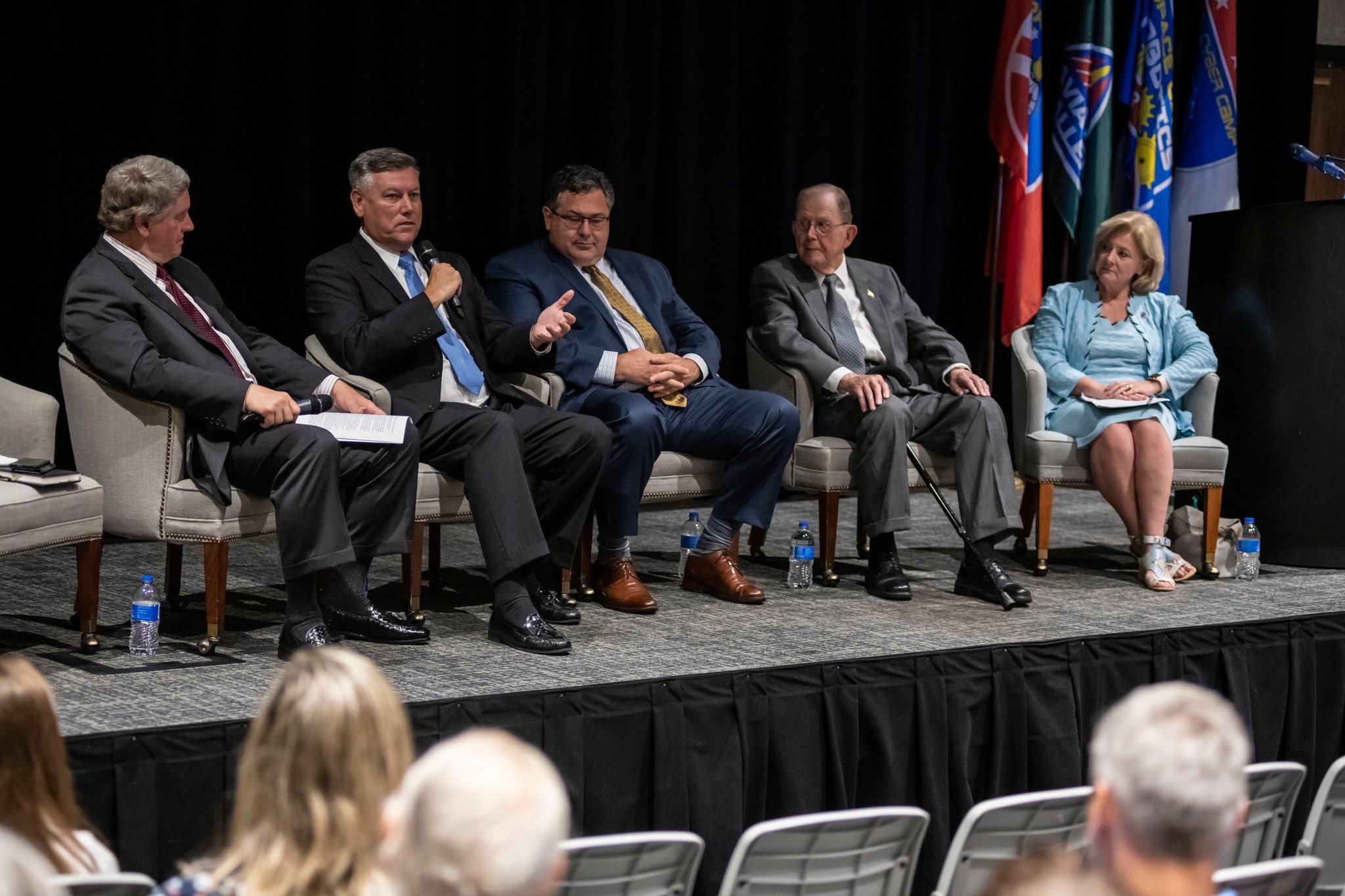
“Many of those things have happened and I still have confidence that the others will happen,” Lucas said during a Pass the Torch panel discussion June 20 at the U.S. Space & Rocket Center, featuring current and past Marshall leadership.
“I encourage the people who are now responsible to move forward,” Lucas continued, eliciting a fist pump from current Marshall Director Jody Singer, who sat next to him. “I think not only the event of going, but the technology developed in getting there, are an absolute necessity for our society. We still need to lead the word in technology for the benefit of all our citizens.”
Marshall’s vital role in the Artemis program, developing the Space Launch System rocket that will send humans to the Moon and Mars, was a frequent topic of discussion among the panel, which also included former Marshall directors Todd May (2016-18) and Patrick Scheuermann (2012-15). Gene Goldman, acting director in 2012, was the moderator.
“The times we work in are very exciting and very challenging,” Singer said. “I’m very proud of the team. It’s really challenging and humbling to know that we’re working on the Space Launch System.”
NASA plans a human return to the Moon by 2024, with sustained human presence on and around Earth’s natural satellite by 2028. Manned missions to Mars would follow in the 2030s. Marshall’s engineers, scientists and technologists will help develop the lunar Gateway’s critical components, lunar landers and the life support systems that will keep astronauts healthy during their travels.
“We have an administration that is supporting us, and now it’s up to execution,” May said. “The hard part is now — getting this rocket finished and getting it to the pad. I know the team is working really hard. I know they’re stressed out. We did our part to tee it up, and Jody is going to bring it home.
“Marshall is very well situated with additive manufacturing,” May added. “We have to get more efficient and more reliable with our life support systems. We’ve been doing it for 40 years and we’re on the cutting edge of that. What we’ve got to continue to do is sell human spaceflight in deep space. If we keep that sold, we’ll have a great future. As Dr. Lucas said, the disciplines and systems engineering and the project management that we do on propulsion translates very well over to science and to all these other technologies. We’re well positioned for the future.”
NASA announced the design for SLS in September 2011, a year before Scheuermann arrived at Marshall. Among his first, and most difficult, tasks was getting the workforce mentally transitioned to a new mission following the cancellation of the Constellation program. His consistent message to employees was to not dwell on the unknowns of the new venture, instead encouraging them to focus on doing their best, with a reminder that those involved at the beginning of the Apollo and space shuttle programs faced similar anxieties.
“The most important thing is you need a rocket, and that’s what Jody is going to deliver with SLS,” Scheuermann said. “The other part is having a workforce that owns it — whatever part an individual plays, be it in the propulsion lab or eco systems, because there are no Walmarts along the way to Mars.”
Boyette, an ASRC Federal/Analytical Services employee and Marshall Star editor, supports the Office of Strategic Analysis & Communications.
NASA Associate Administrator Jurczyk, Deputy Associate Administrator Saunders Meet with Marshall Team
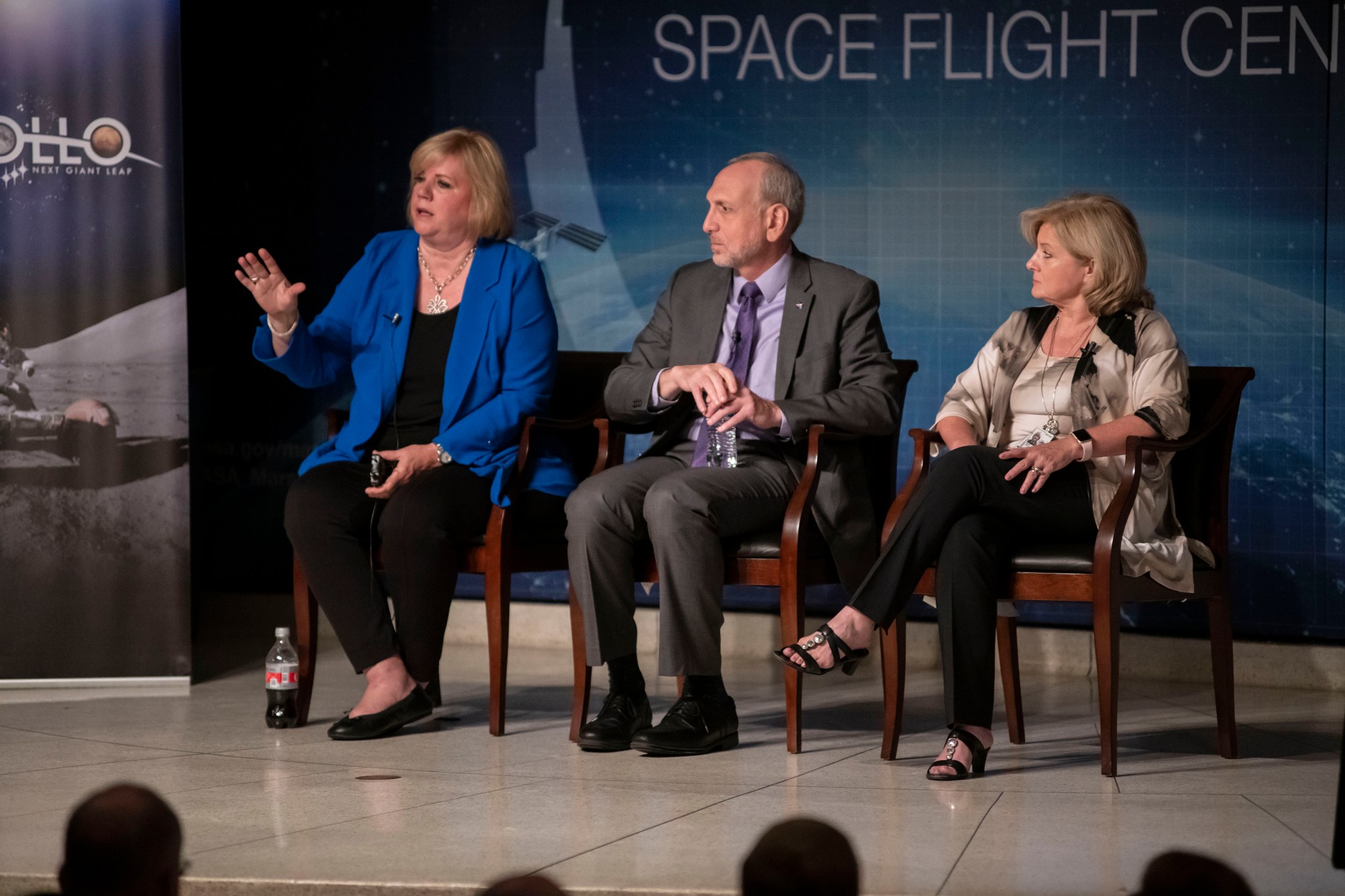
From left, NASA Deputy Associate Administrator Melanie Saunders, NASA Associate Administrator Steve Jurczyk and NASA Marshall Space Flight Center Director Jody Singer answer questions during an all-hands meeting at Marshall June 19. Jurczyk discussed programmatic enablers that will allow NASA to land astronauts on the Moon in 2024, while Saunders highlighted agency operating models including Mission Support Architecture, or MAP. The all-hands was part of Jurczyk and Saunders’ tour of NASA field centers. (NASA/Fred Deaton)
Marshall Leaders: Employee Survey Vital to Success — and Data Proves It
By Rick Smith
In 2018, for the seventh straight year, NASA was named the best place to work in the federal government, according to a Partnership for Public Service survey of some 600,000 federal workers. Marshall Space Flight Center ranked 18th among all federal agency subcomponents.
Those rankings are the result of civil servant participation in the annual Federal Employee Viewpoint Survey, and the use of survey data by Marshall leaders to demonstrate which areas are thriving and which to target for continued improvement, according to Neil Rodgers, director of Marshall’s Office of the Chief Information Officer.
More importantly, participation helps guide Marshall’s ability to most effectively carry out its NASA mission, said Marshall Director Jody Singer. That encompasses its full breadth of work on the Artemis Program, the Space Launch System, the International Space Station, advanced technology development and crucial science programs and activities.
Singer, Rodgers and other Marshall leaders encourage all civil servants to participate in the survey, which concludes at 11:59 p.m. July 5. Supervised by the Office of Personnel Management, the survey is open to full-time and part-time civil servants hired or made permanent by October 2018.
And the data has borne out its value in refining workflows and boosting job satisfaction. In 2017-2018, the Office of the Chief Financial Officer used findings from the survey to enhance its approach to management tactics, fine-tuning its communication methods, career development offerings and team-building activities. The office introduced a series of workshops, open to everyone in the organization, to stimulate strategic planning, clarify roles and responsibilities, and promote well-being during times of change.
As a result, the office saw a 20% improvement in overall satisfaction from 2017 to 2018, and a corresponding leap of nearly 20% in employees’ feeling of personal empowerment with regard to their work processes.
Similarly, the Space Launch System Program Office, the Office of the Chief Information Officer, the Office of Procurement and the Engineering Directorate’s Test Laboratory saw overall satisfaction statistics among their teams climb 12.3% to 14.8% between 2014 and 2018. Those organizations undertook similar strategies to better inform, empower and recognize team members, increase collaboration and promote accountability, focusing on strategies to acknowledge, champion and nurture employees’ personal stake in the success of the organization, the center and the agency.
Marshall’s Organization and Leadership Development Office, part of the Office of Human Resources, helped the Test Laboratory devise a special “Things We Can Control & Things We Can Influence” training program to determine how best to refine and enhance the organization’s existing communications, training, awards and team-building activities.
James Andrews, who manages the Organization and Leadership Development Office, said his team specializes in working with employees at every level to improve existing workflows and increase trust, confidence and morale through communication, career development and recognition.
“It’s our goal to help workers who share an org code to evolve into a strong coalition who support and uplift one another every day, helping to ensure their continued success,” he said. “The Employee Viewpoint Survey is a great tool for opening a conversation about how we can work together to improve, benefiting all of Marshall and NASA.”
This year’s survey expands the “Work-Life” and “Demographic” sections to help NASA further improve those areas of employee job satisfaction. It also invites comments about the partial government shutdown in the winter of 2018-2019.
The email-based survey is voluntary and takes approximately 25 minutes to complete. All responses are confidential. Employees hired or made permanent after October 2018 will be eligible to take part in the 2020 survey. Eligible civil service employees who have not yet received an email invitation should contact OPM at EVNN@opm.gov.
Smith, an ASRC Federal/Analytical Services employee, supports the Office of Strategic Analysis & Communications.
Volunteers Needed for World Record Rocket Launch Attempt
By Will Bryan
There’s nothing like the “whoosh” of a model rocket launching and soaring upward. As the solid fuel burns — emitting white smoke — the rocket pierces the sky. Now, imagine 5,000 rockets launching at the same time. That’s what is planned for July 16 at the U.S. Space & Rocket Center in Huntsville during an attempt at a Guinness World Record.
Volunteers are needed in three main areas to help make the attempt a success:
- Rocket Construction — Volunteers will build small model rockets – the same used for Space Camp’s Pathfinder teams — in assembly line fashion. Sessions will last two to three hours.
- Frame Wiring — The e-matches are wired in series throughout the frame. This will be completed on-site the weekend prior to the launch. Sessions will be two to three hours each.
- Launch Day Setup — Set up rockets on the launch pads and prepare the field for the attempt.
Signup is available online for assembly, wiring and setup.
In order to carefully control the process, volunteer participation is limited to adults.
The public is invited to witness the attempt at the U.S. Space & Rocket Center at 8:30 a.m. July 16.
The world record attempt is one of many events happening in the “Rocket City” to celebrate the 50th anniversary of the Apollo 11 Moon landing. NASA’s Marshall Space Flight Center played a vital role in the Apollo program, developing the rockets that launched the humans and hardware into space.
Bryan, an ASRC Federal/Analytical Services employee, supports the Office of Strategic Analysis & Communications.
Marshall’s David Burns Shares His Experiences Reactivating the SR-71 Blackbird
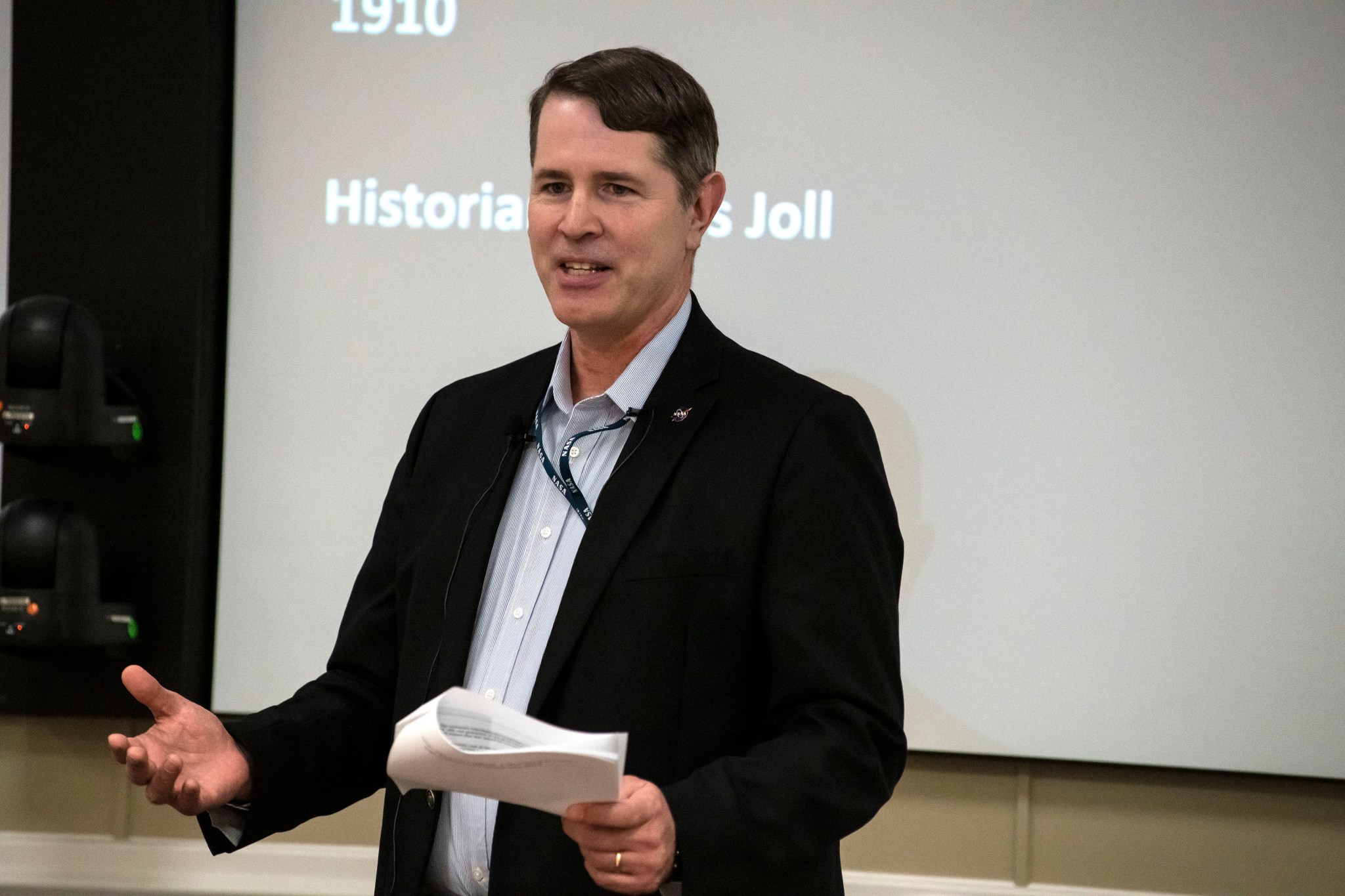
David Burns, director of the Science and Technology Office at NASA’s Marshall Space Flight Center, shares his experiences leading the effort to reactivate the SR-71 Blackbird aircraft as part of the “Mission Success is in Our Hands” lecture series June 20. Burns led the effort to reactivate the classified surveillance and reconnaissance aircraft while he was in the U.S. Air Force. The lecture series — sponsored by Marshall’s Safety & Mission Assurance Directorate and industry partner Jacobs Engineering of Huntsville — is designed to strengthen Marshall’s focus on all aspects of crew, hardware and mission safety. Prior to Burns’ talk, Marshall’s Barbara Todd and Rocky Stevens were presented with the Golden Eagle Award for actions preventing damage to or loss of flight hardware. (NASA/Fred Deaton)
Marshall Medical Center to Offer New Options to Civil Servants, Contractors
By Rick Smith
Bringing commercial medical services to NASA’s Marshall Space Flight Center will mark an exciting new chapter in on-site, urgent care clinical options.
“Your health is our mission,” said Roy Malone, director of the Office of Center Operations. “We’re always looking for new and innovative ways of doing things to benefit our team, reducing costs and increasing services. Marshall is the pilot for implementing NASA’s new commercial medical model, reflecting the agency’s vision for medical services at all its field centers.”
Beginning Oct. 1, the Marshall Medical Center will provide full, walk-in clinic services to all Marshall civil service employees and contractors. For the first time, contractors will be able to obtain urgent care, written prescriptions and onsite health maintenance physicals through the use of personal insurance. Annual physical exams and urgent care needs for civil servants will continue to be available through the use of their personal insurance.
“We’re excited to be able to offer these services to the entire Marshall team,” Malone said. “We’ll still have the benefits of our existing medical clinic, with added convenience and options for our team as a whole — civil service and contractors alike.”
InoMedic Health Applications of Hampton, Virginia, was awarded the occupational health services contract at Marshall in May.
Under the new contract, annual, voluntary health maintenance physicals will be billed to personal health care insurance — much the way yearly flu shots currently are administered. No additional out-of-pocket expenses are anticipated for team members who obtain their annual physicals at the clinic. Copies of physical results will continue to be available for those who elect to share the results with their primary care physicians.
Government-provided NASA and Occupational Safety and Health Administration certification physicals for contractors will be phased out over a four-year period beginning in fiscal year 2020. Companies will be able to partner with the new medical services contractor, however, to obtain not only required certification physicals but also drug screening tests for employees as required.
“Keeping these services available on-site for our contractor team members is vital to keeping time away from the workplace to a minimum,” said Farley Davis, manager of Marshall’s Environmental Engineering and Occupational Health Office.
Until the contract changeover, physicals required by NASA or OSHA will continue for civil servants and contractors under the existing medical services contract, Farley said.
“This model will allow the new medical services contractor to act as an entrepreneur, potentially expanding their services over time as demand increases and business grows,” Malone said. He and Davis encourage team members to visit ExplorNet for additional updates about the new Medical Center contract and services.
The Marshall Medical Center is at 4249 Morris Road on Redstone Arsenal.
Smith, an ASRC Federal/Analytical Services employee, supports the Office of Strategic Analysis & Communications.
Marshall Team, Local Partners Host ‘Take Our Children to Work Day’
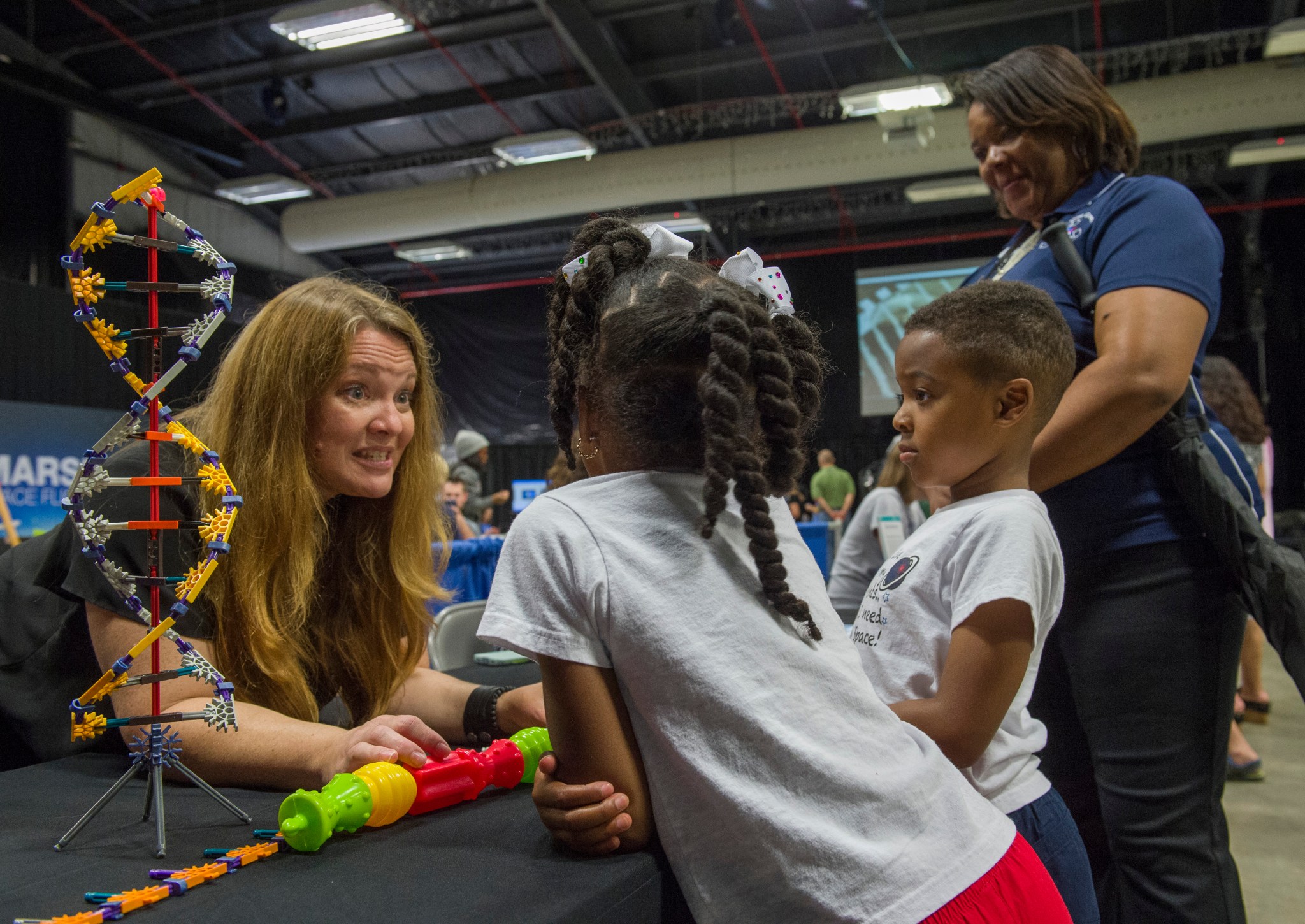
Ava Schaefer, left, a payroll specialist at HudsonAlpha Institute for Biotechnology in Huntsville, talks to 6-year-olds Baelyn and Braelen Green about DNA and the importance of healthy human biology in long-duration voyages to the Moon, Mars and other destinations, during “Take Our Children to Work Day,” June 19 at NASA’s Marshall Space Flight Center. The twins’ mother, Tameka Page-Green, right, is a center service delivery manager for the NASA Integrated Communications Services contract, supporting Marshall’s Office of the Chief Information Officer. Families also took virtual reality tours of the Space Launch System and explored Marshall’s Flight Dynamics Laboratory, 3D printing laboratory and the Payload Operations Integration Center. Marshall’s annual Take Our Children to Work Day is organized each year by Marshall’s Office of Diversity and Equal Opportunity. (NASA/Emmett Given)
NASA Technology Missions Launch on SpaceX Falcon Heavy
NASA technology demonstrations and science missions have launched into space on a Falcon Heavy rocket.
The NASA payloads lifted off at 1:30 a.m. CDT, June 25 from NASA’s Kennedy Space Center as part of the Department of Defense’s Space Test Program-2 — STP-2 — launch. The technology demonstrations could help the agency get astronauts to Mars, while the science missions will look at the space environment around Earth and how it affects us. Two of the technologies — the Green Propellant Infusion Mission and the Deep Space Atomic Clock — are part of NASA’s Technology Demonstration Missions program managed at NASA’s Marshall Space Flight Center.
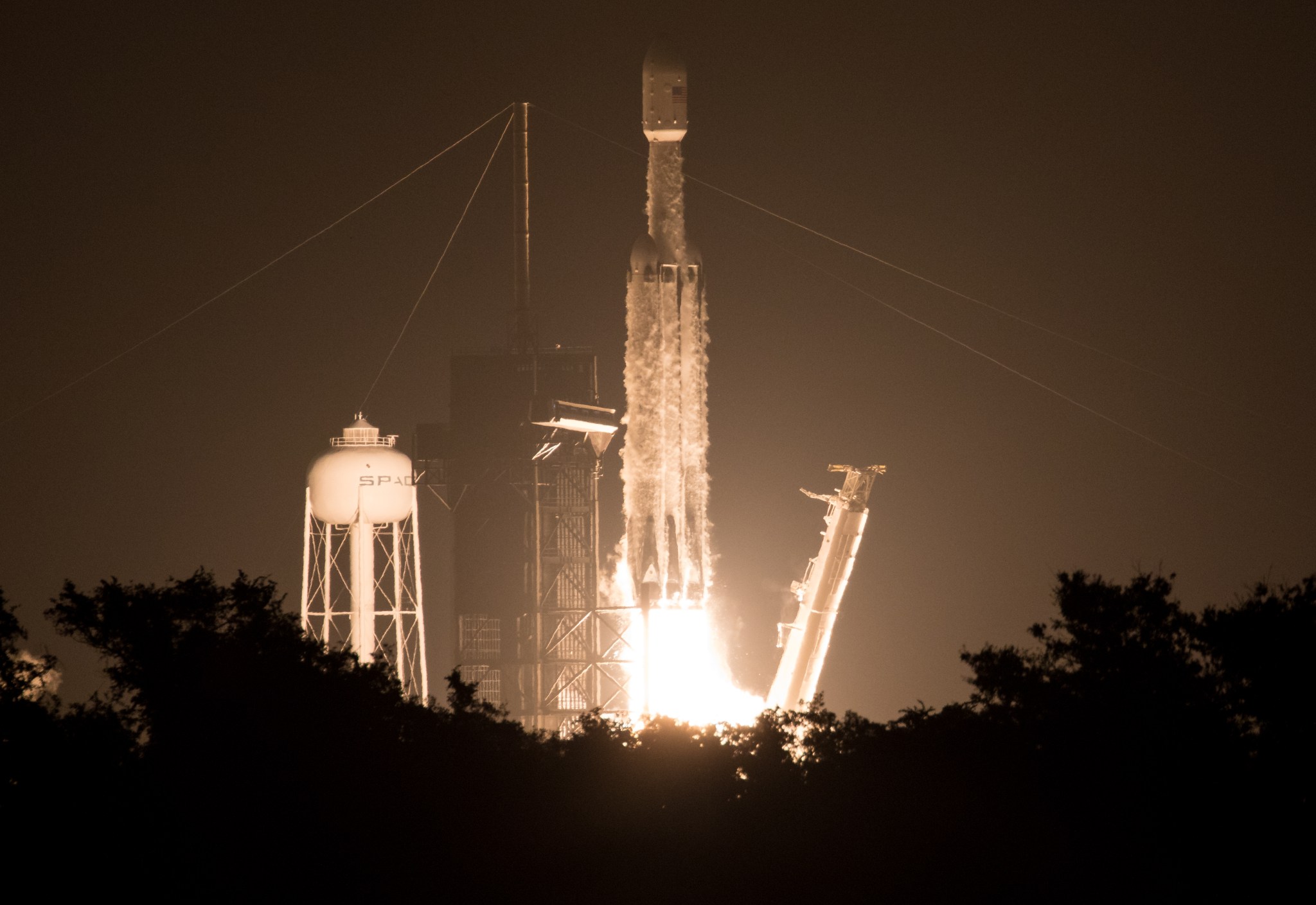
“This launch was a true partnership across government and industry, and it marked an incredible first for the U.S. Air Force Space and Missile Systems Center,” said Jim Reuter, associate administrator for NASA’s Space Technology Mission Directorate. “The NASA missions aboard the Falcon Heavy also benefited from strong collaborations with industry, academia and other government organizations.”
The missions will aid in smarter spacecraft design and benefit the agency’s Moon to Mars exploration plans by providing greater insight into the effects of radiation in space and testing an atomic clock that could change how spacecraft navigate.
With launch and deployments complete, the missions will start to power on, communicate with Earth and collect data. Each will operate for about a year, providing enough time to mature the technologies and collect valuable science data.
NASA’s Deep Space Atomic Clock is a toaster-oven-sized instrument traveling aboard a commercial satellite that was released into low-Earth orbit. The unique clock will test a new way for spacecraft to navigate in deep space. The technology could make GPS-like navigation possible at the Moon and Mars.
The Green Propellant Infusion Mission immediately began to power on after deployment. GPIM will test a new propulsion system that runs on a high-performance and non-toxic spacecraft fuel. This technology could help propel constellations of small satellites in and beyond low-Earth orbit.
Two NASA CubeSats making up the Enhanced Tandem Beacon Experiment will work with NOAA’s COSMIC-2 mission, six satellites that each carry a radio occultation — GPS — receiver developed at NASA’s Jet Propulsion Laboratory. The mission will explore bubbles in the electrically charged layers of Earth’s upper atmosphere, which can disrupt communications and GPS signals that we rely on every day. The CubeSats will send signals in several frequencies to receiving stations on Earth. Scientists will measure any disruptions in these signals to determine how they are being affected by the upper atmosphere.
The U.S. Air Force Research Laboratory’s Demonstration and Science Experiments was the last spacecraft to be released from STP-2. Aboard is an instrument designed by JPL to measure spacecraft vibrations and four NASA experiments that make up the Space Environment Testbeds. SET will study how to better protect satellites from space radiation by analyzing the harsh environment of space near Earth and testing various strategies to mitigate the impacts. This information can be used to improve spacecraft design, engineering and operations in order to protect spacecraft from harmful radiation driven by the Sun.
Does the Gas in Galaxy Clusters Flow Like Honey?
This image represents a deep dataset of the Coma galaxy cluster obtained by NASA’s Chandra X-ray Observatory — a program managed by NASA’s Marshall Space Flight Center. Researchers have used these data to study how the hot gas in the cluster behaves. One intriguing and important aspect to study is how much viscosity, or “stickiness,” the hot gas demonstrates in these cosmic giants. Read more. (X-ray: NASA/CXC/Univ. of Chicago, I. Zhuravleva et al, Optical: SDSS)
I Am Building SLS: Debra King
As a child, my bedroom was adorned with NASA posters, and I would lay awake at night dreaming of space exploration. Growing up in Wisconsin — far away from the Space Coast — I never could have imagined that I would make my way to Florida fresh out of college to work with NASA on the Space Shuttle Program, and now the Space Launch System (SLS) — the most powerful rocket ever built — that will send the first woman and the next man to the Moon.
Test engineers for Northrop Grumman, in the Aft Skirt Test Facility at NASA’s Kennedy Space Center, work with hazardous chemicals and vapors that are part of the rocket’s propulsion system. We wear self-contained atmospheric protection ensembles — or SCAPE suits — that include rubber boots with seals and a helmet with a breathing apparatus to protect us from the chemicals and their vapors expelled during testing. The aft skirt thrust vector control system for the solid rocket boosters is tested at the Aft Skirt Test Facility. The twin set of solid rocket boosters produce the 7.2 million pounds of thrust SLS needs to get off the launch pad and into space. The aft skirt assemblies for the boosters literally provide a foundation for the rocket because they are the attach points between the SLS launch vehicle and the mobile launcher. They support the rocket’s massive core stage and the Orion spacecraft – the crewed vehicle that sits on top of the rocket — on the launch pad for all conditions before booster ignition.
In June, we will begin major testing on the boosters that will be flown on the first mission of SLS, Artemis 1. The forward skirt assemblies and aft skirts of the solid rocket boosters were used on space shuttle flights and are now being refurbished at Kennedy. My team is responsible for adding new, modernized avionics systems to the boosters. Specifically, we ensure the new booster avionics systems, the hydraulic system operation of the thrust vector control system that steers the booster and the hydrazine fuel system will perform correctly on launch day.
Testing culminates with what is known as an aft skirt hot fire. The hot fire runs a nominal booster mission profile and includes all failure modes that might occur during vehicle ascent through booster separation. Upon successful completion of the hot fire, the thermal vector control systems are deserviced and the aft skirts can be transported to the Rotation, Processing and Surge Facility where they are joined to the aft motor segments. The aft skirt assemblies, then fully assembled, will roll over to the Vertical Assembly Building to be stacked and integrated with the rest of the rocket for Artemis 1.
When I heard the recent charge from the president to send astronauts to the Moon in 2024, I was excited to think about how I will be part of American history. I can’t wait to watch SLS launch from Kennedy alongside my two children.
This Week in NASA History: Marshall Captive-Fires F-1 Engine on a First Run – June 29, 1967
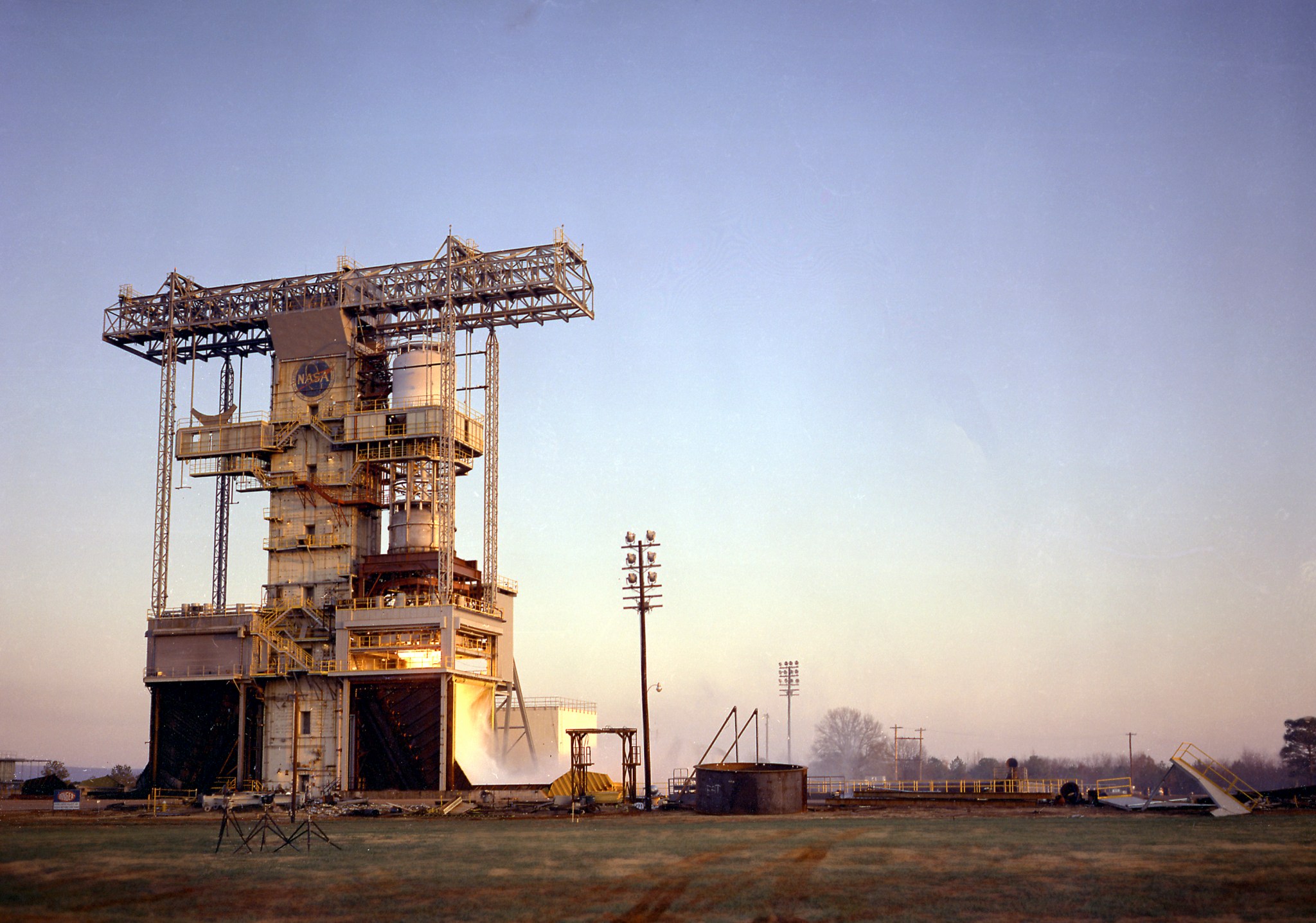
This week in 1966, technicians at NASA’s Marshall Space Flight Center captive-fired the F-1 engine on a first run for about 40 seconds. The engine, developed by Rocketdyne under the direction of Marshall, was propelled by a mixture of RP-1, a type of kerosene, and liquid oxygen. The engine was used in a cluster of five engines to propel the first, or S-IC, stage of the Saturn V rocket. Each engine produced 1.5 million pounds of thrust. Here, the engine is tested on the modified Saturn IB static test stand at Marshall. This July, in a series of special events, NASA is marking the 50th anniversary of the Apollo Program – the historic effort that sent the first U.S. astronauts into orbit around the Moon in 1968, and landed a dozen astronauts on the lunar surface between 1969 and 1972. For more pictures, and to connect to NASA’s remarkable history, visit the Marshall History Program’s webpage. (NASA)


























